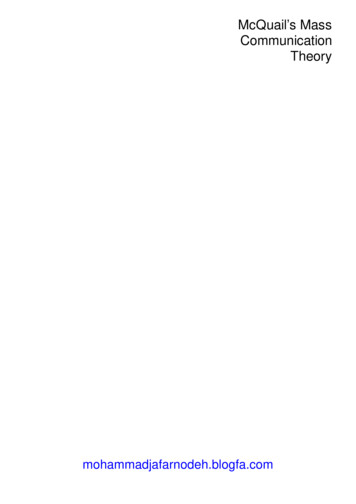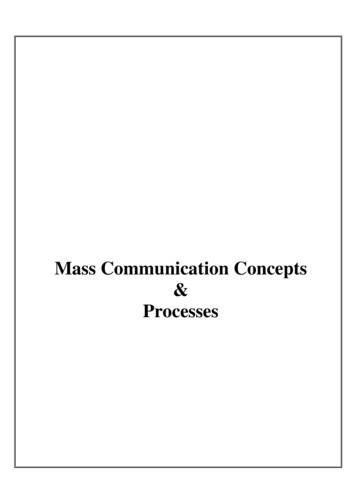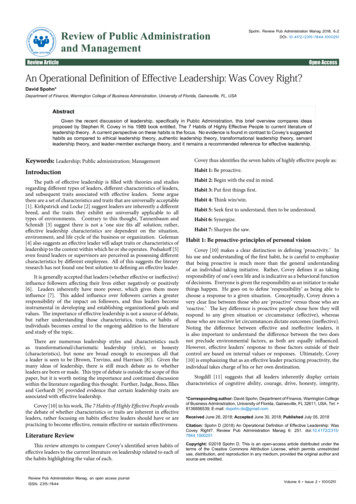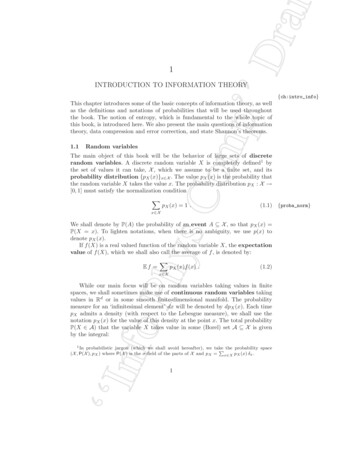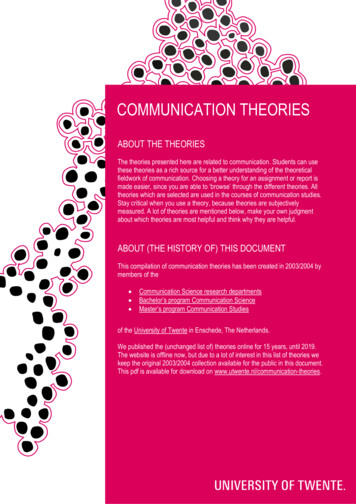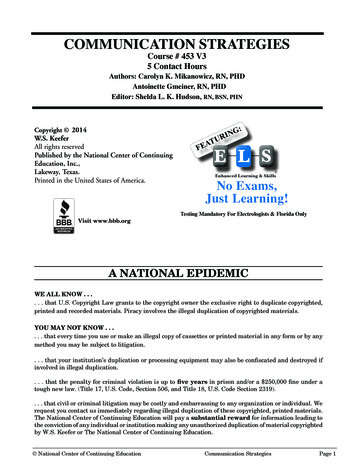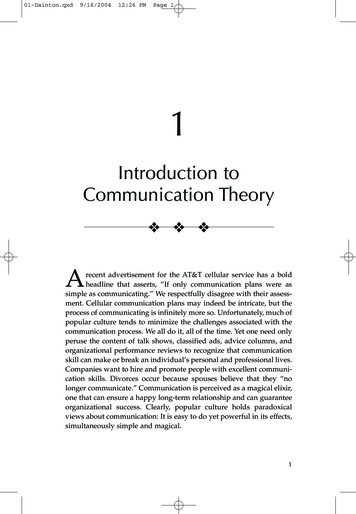
Transcription
01-Dainton.qxd9/16/200412:26 PMPage 11Introduction toCommunication Theory Arecent advertisement for the AT&T cellular service has a boldheadline that asserts, “If only communication plans were assimple as communicating.” We respectfully disagree with their assessment. Cellular communication plans may indeed be intricate, but theprocess of communicating is infinitely more so. Unfortunately, much ofpopular culture tends to minimize the challenges associated with thecommunication process. We all do it, all of the time. Yet one need onlyperuse the content of talk shows, classified ads, advice columns, andorganizational performance reviews to recognize that communicationskill can make or break an individual’s personal and professional lives.Companies want to hire and promote people with excellent communication skills. Divorces occur because spouses believe that they “nolonger communicate.” Communication is perceived as a magical elixir,one that can ensure a happy long-term relationship and can guaranteeorganizational success. Clearly, popular culture holds paradoxicalviews about communication: It is easy to do yet powerful in its effects,simultaneously simple and magical.1
01-Dainton.qxd29/16/200412:26 PMPage 2APPLYING COMMUNICATION THEORY FOR PROFESSIONAL LIFEThe reality is even more complex. “Good” communication meansdifferent things to different people in different situations. Accordingly,simply adopting a set of particular skills is not going to guarantee success.Those who are genuinely good communicators are those who understand the underlying principles behind communication and are able toenact, appropriately and effectively, particular communication skills asthe situation warrants. This book seeks to provide the foundation forthose sorts of decisions. We focus on communication theories that canbe applied in your personal and professional lives. Understandingthese theories, including their underlying assumptions and the predictions that they make, can make you a more competent communicator. WHAT IS COMMUNICATION?This text is concerned with communication theory, so it is important tobe clear about the term communication. The everyday view of communication is quite different from the view of communication taken bycommunication scholars. In the business world, for example, a popularview is that communication is synonymous to information. Thus, thecommunication process is the flow of information from one person toanother (Axley, 1984). Communication is viewed as simply one activityamong many others, such as planning, controlling, and managing(Deetz, 1994). It is what we do in organizations.Communication scholars, on the other hand, define communication as the process by which people interactively create, sustain,and manage meaning (Conrad & Poole, 1998). As such, communication both reflects the world and simultaneously helps to create it.Communication is not simply one more thing that happens in personaland professional life; it is the very means by which we produce ourpersonal relationships and professional experiences—it is how we plan,control, manage, persuade, understand, lead, love, and so on. All of thetheories presented in this book relate to the various ways in whichhuman interaction is developed, experienced, and understood. WHAT IS THEORY?The term theory is often intimidating to students. We hope that by thetime you finish reading this book, you will find working with theory to
01-Dainton.qxd9/16/200412:26 PMPage 3Introduction to Communication Theory3be less daunting than you might have expected. The reality is that youhave been working with theories of communication all of your life,even if they haven’t been labeled as such. Theories simply provide anabstract understanding of the communication process (Miller, 2002). Asan abstract understanding, they move beyond describing a single eventby providing a means by which all such events can be understood. Toillustrate, a theory of customer service can help you to understand notonly the bad customer service you received from your credit card company this morning, it can also help you to understand a good customerservice encounter you might have had at a restaurant last week.Moreover, it can assist your organization in training and developingcustomer service personnel.At their most basic level, theories provide us with a lens by whichto view the world. Think of theories as a pair of glasses. Correctivelenses allow wearers to observe more clearly, but they also impactvision in unforeseen ways. For example, they can limit the span ofwhat you see, especially when you try to look peripherally outside therange of the frames. Similarly, lenses can also distort the things yousee, making objects appear larger or smaller than they really are. Youcan also try on lots of pairs of glasses until you finally pick one pairthat works the best for your lifestyle. Theories operate in a similarfashion. A theory can illuminate an aspect of your communication sothat you understand the process much more clearly; theory also can hidethings from your understanding or distort the relative importance ofthings.We consider a communication theory to be any systematic summaryabout the nature of the communication process. Certainly, theories cando more than summarize. Other functions of theories are to focus attention on particular concepts, clarify our observations, predict communication behavior, and generate personal and social change (Littlejohn,1999). We do not believe, however, that all of these functions are necessaryfor a systematic summary of communication processes to be considereda theory.What does this definition mean for people in communication, business, and other professions? It means that any time you say that a communication strategy usually works this way at your workplace, or thata specific approach is generally effective with your boss, or that certaintypes of communication are typical for particular media organizations,you are in essence providing a theoretical explanation. Most of us make
01-Dainton.qxd49/17/20042:34 PMPage 4APPLYING COMMUNICATION THEORY FOR PROFESSIONAL LIFETable 1.1Three Types of TheoryType of TheoryExampleCommonsensetheory Never date someone you work with—it always endsup badly. The squeaky wheel gets the grease. The more incompetent you are, the higher you getpromoted.Working theory Audience analysis should be done prior to presentinga speech. To get a press release published, it should benewsworthy and written in journalistic style.Scholarly theory Effects of violations of expectations depend on thereward value of the violator (expectancy violationstheory). The media do not tell us what to think, but what tothink about (agenda-setting theory).these types of summary statements on a regular basis. The differencebetween this sort of theorizing and the theories provided in this bookcenters on the term systematic in the definition. Table 1.1 presents anoverview of three types of theory.First, the summary statements described in the table are whatare known as commonsense theories, or theories-in-use. This type oftheory often is created by an individual’s own personal experiences, orsuch theories might reflect helpful hints that are passed on from familymembers, friends, or colleagues. They are useful to us and are often thebasis for our decisions about how to communicate. Sometimes, however, our commonsense backfires. For example, think about commonknowledge regarding deception. Most people believe that liars don’tlook the person they are deceiving in the eyes, yet research indicatesthat this is not the case (DePaulo, Stone, & Lassiter, 1985). Let’s face it:If we engage in deception, we will work very hard at maintaining eyecontact simply because we believe that liars don’t make eye contact! Inthis case, commonsense theory is not supported by research into thephenomenon.A second type of theory is known as working theory. These aregeneralizations made in particular professions about the best techniquesfor doing something. Journalists work using the “inverted pyramid” of
01-Dainton.qxd9/16/200412:26 PMPage 5Introduction to Communication Theory5story construction (most important information to least importantinformation). Filmmakers operate using particular shots to invoke particular effects in the audience, so close-ups are used when a filmmakerwants the audience to place particular emphasis on the object in theclose-up. Giannetti (1982), for example, describes a scene in Hitchcock’sNotorious in which the heroine realizes she is being poisoned by hercoffee, and the audience “sees” this realization through a close-up ofthe coffee cup. Working theories are more systematic than are commonsense theories, because they represent agreed-on ways of doing thingsfor a particular profession. In fact, they may very well be based onscholarly theories. Such theories more closely represent guidelines forbehavior rather than systematic representations. These types oftheories are typically taught in content-specific courses (such as publicrelations, media production, or public speaking).The type of theory we will be focusing on in this book is known asscholarly theory. Students often assume (incorrectly!) that because atheory is labeled as scholarly, it is not useful for people in business andthe professions. Instead, the term scholarly indicates that the theory hasundergone systematic research. Accordingly, scholarly theories providemore thorough, accurate, and abstract explanations for communication than do commonsense or working theories. The down side is thatscholarly theories are typically more complex and difficult to understand than commonsense or working theories. If you are genuinelycommitted to improving your understanding of the communicationprocess, however, scholarly theory will provide a strong foundation fordoing so. THE THEORY–RESEARCH LINKAlthough theory and research are related, we have not yet articulatedthe exact nature of this link, in part because there is some debate aboutthe theory–research relationship that is akin to the classic question,which came first, the chicken or the egg? In this case, scholars disagreeas to what starts the process, theory or research.Some scholars say that research comes before theory. Thisapproach is known as inductive theory development. Also known asgrounded theory, scholars using inductive theory development believethat the best theories emerge from the results of systematic study
01-Dainton.qxd69/16/200412:26 PMPage 6APPLYING COMMUNICATION THEORY FOR PROFESSIONAL LIFE(Glaser & Strauss, 1967). That is, these scholars study a particular topic,and, based on the results of their research, they develop a theory;the research comes before the theory. If someone wanted to develop atheory about how management style affects employee performance,then that person would study management style and employeeperformance in great depth before proposing a theory. Preliminarytheories may be proposed, but the data continue to be collected andanalyzed until adding new data brings little to the researcher’s understanding of the phenomenon or situation.On the other hand, some scholars believe in deductive theorydevelopment. Deductive theory is generally associated with thescientific method (Reynolds, 1971). The deductive approach requiresthat a hypothesis, or a working theory, be developed before anyresearch is conducted. Once the theory has been developed, thetheorist then collects data to test or refine the theory (i.e., to supportor reject the hypothesis). What follows is a constant set of adjustmentsto the theory with additional research conducted until evidence insupport of the theory is overwhelming. The resulting theory is knownas a law (Reynolds, 1971). In short, deductive theory developmentstarts with the theory and then looks at data. As an example, aresearcher might start with the idea that supportive managementstyles lead to increased employee performances. The researcher wouldthen seek to support his or her theory by collecting data about thosevariables.As indicated earlier, these two approaches represent different starting points to what is in essence a “chicken or the egg” type of argument. The reality is that neither approach advocates a single cycle oftheorizing or research. Instead, both approaches suggest that theoriesare dynamic—they are modified as the data suggest, and data arereviewed to adjust the theory. Accordingly, the model in Figure 1 is themost accurate illustration of the link between theory and research. Inthis model, the starting points are different, but the reality of a repetitive loop between theory and research is identified. WHAT IS RESEARCH?Thus far, we have talked about the nature of communication and thenature of theory. Next we turn our attention to the question of what
01-Dainton.qxd9/16/200412:26 PMPage 7Introduction to Communication TheoryFigure 1.17The Theory–Research LinkDeductiveTheoryResearchInductivecounts as research. Frey, Botan, and Kreps (2002) described researchas “disciplined inquiry that involves studying something in a plannedmanner and reporting it so that other inquirers can potentially replicate the process if they choose” (p. 13). Accordingly, we do not meaninformal types of research, such as reflections on personal experience,off-the-cuff interviews with acquaintances, or casual viewing of communication media. When we refer to research, we mean the methodical gathering of data as well as the careful reporting of the results ofthe data analysis.Note that how the research is reported differentiates two categoriesof research. Primary research is research reported by the person whoconducted it. It is typically published in academic journals. Secondaryresearch is research reported by someone other than the person whoconducted it. This is research reported in newspapers, popular ortrade magazines, handbooks, and textbooks. Certainly, there is valueto the dissemination of research through these media. Textbooks, forexample, can summarize hundreds of pages of research in a compactand understandable fashion. Newspaper articles or news broadcastscan reach thousands of people. Trade magazines can pinpoint thereaders who may benefit most from the results of the research.Regardless of whether the source is popular or academic, however,primary research is typically valued more than secondary research asa source of information; with secondary research, readers risk thechance that the writers have misunderstood or distorted the results ofthe research.
01-Dainton.qxd89/16/200412:26 PMPage 8APPLYING COMMUNICATION THEORY FOR PROFESSIONAL LIFE RESEARCH METHODS IN COMMUNICATION“The sheer volume of research we are exposed to in our daily lives isformidable and growing” (Crossen, 1994, p. 17). Even if you aren’t anacademic, even if your job doesn’t require you to conduct research, weare all inundated with research “facts,” both at work and at home.Politicians cite polls and surveys to bolster their platforms. Advertiserscite research studies that indicate their product is superior. Organizations use research to make decisions for strategic planning. Even ifyou never conduct a research study in your life, understanding howresearch is performed will help you make more informed personal andprofessional decisions. This section focuses on the four research methodscommonly used in the development of communication theory. Whenreading about these methods, pay particular attention to the types ofinformation revealed and concealed by each method. This approachwill allow you to be a better consumer of research.ExperimentsWhen people think of “experiments,” they often have flashbacksto high school chemistry classes. People are often surprised that communication scholars also use experiments, even though there isn’t a Bunsenburner or beaker in sight. What makes something an experiment hasnothing to do with the specific equipment involved; rather, experimentation is ultimately concerned with causation and control. It is important toemphasize that an experiment is the only research method that allowsresearchers to conclude that one thing causes another. For example, if youare interested in determining whether friendly customer service causesgreater customer satisfaction, whether advertisers’ use of bright colorsproduces higher sales, or whether sexuality in film leads to a morepromiscuous society, the only way to determine these things is throughexperimental research.Experimental research allows researchers to determine causalitybecause experiments are so controlled. In experimental research, theresearcher is concerned with two variables. A variable is simply anyconcept that has two or more values (Frey et al., 2002). Sex is a variable,because we have men and women. Note that just looking at malenessis not a variable because there is only one value associated with it; itdoesn’t vary, so it isn’t a variable. Masculinity is considered a variable,
01-Dainton.qxd9/16/200412:26 PMPage 9Introduction to Communication Theory9however, because you can be highly masculine, moderately masculine,nonmasculine, and so on.Returning to our discussion of experimental research, then, theresearch is concerned with two variables. One of the variables is thepresumed cause. This is known as the independent variable. The otheris the presumed effect. This is known as the dependent variable. If youare interested in knowing whether bright colors in advertisements causeincreased sales, your independent variable is the color (bright vs. dull)and the dependent variable is the amount of sales dollars (more, thesame, or less). The way the researcher determines causality is by carefullycontrolling the study participants’ exposure to the independent variable.This control is known as manipulation, a term which has a negativeconnotation but is not meant in a negative fashion in the research world.In the study of advertisements just described, the researcher wouldexpose some people to an advertisement that used bright colors andothers to an advertisement that used dull colors, and she or he wouldobserve the effects on sales based on these manipulations.Experiments take place in two settings. Laboratory experimentstake place in a controlled setting, so that the researcher might bettercontrol his or her efforts at manipulation. In the communication field,laboratories are often rooms that simulate living rooms or conferencerooms. Typically, however, they have two-way mirrors and camerasmounted on the walls to record what happens. For example, JohnGottman has a mini “apartment” at the University of Washington.He has married couples “move in” to the apartment during the courseof a weekend, and he observes all of their interaction during thatweekend.Some experiments don’t take place in the laboratory, and theseare called field experiments because they take place in participants’natural surroundings. These sorts of experiments often take place inpublic places, such as shopping malls, libraries, or schools, but theymight take place in private areas as well. In all cases, participants mustagree to be a part of the experiment to comply with ethical standardsset by educational and research institutions.Survey ResearchThe most common means of studying communication is through theuse of surveys. Market research, audience analysis, and organizational
01-Dainton.qxd109/16/200412:26 PMPage 10APPLYING COMMUNICATION THEORY FOR PROFESSIONAL LIFEaudits all make use of surveys. Unlike experiments, the use of surveysdoes not allow researchers to make claims that one thing causes another.The strength of survey research is that it is the only way to find out howsomeone thinks, feels, or intends to behave. If you want to know whatpeople think about your organization, how they feel about a socialissue, or whether they intend to buy a product after viewing an advertising spot you created, you need to conduct a survey.In general, there are two types of survey research. Interviews askparticipants to respond orally. They might take place face-to-face orover the phone. One special type of interview is a focus group, whichis when the interviewer (called a facilitator) leads a small group ofpeople in a discussion about a specific product or program (Frey et al.,2002). Questionnaires ask participants to respond in writing. They canbe distributed by mail or administered with the researcher present.Particular types of research are more suited for interviews rather thanquestionnaires. Interviews, for example, allow the researcher to askmore complex questions because he or she can clarify misunderstandings through probing questions. Questionnaires, however, might bemore appropriate for the collection of sensitive information becausethey provide more anonymity to the respondent (Salant & Dillman,1994).The key concepts associated with either type of survey researchare questioning and sampling. First, the purpose of a survey is quitesimple; surveys provide a means to ask questions of a group of peopleto understand their thoughts, feelings, and behaviors. Questionnairesmight take two forms. Open-ended questions allow respondents toanswer in their own words, taking as long (or short) as they wouldlike. For example, a market researcher might ask study participants todescribe what they like about a particular product. Or an interviewermight ask someone to respond to a hypothetical situation. Closedended questions require respondents to respond using set types ofanswers. In this case, a market researcher might say something like,“Respond to the following statement: product X is a useful product.Would you say you strongly agree, agree, neither agree nor disagree,disagree, or strongly disagree?” Neither method is better than the other;the two types of questions simply provide different kinds of data thatare analyzed using different means.The second key concept associated with survey research is sampling. Researchers are typically concerned with large groups of people
01-Dainton.qxd9/16/200412:26 PMPage 11Introduction to Communication Theory11when they conduct surveys. These groups are known as a population,which means all people who possess a particular characteristic (Freyet al., 2002). For example, marketing firms want to study all possibleconsumers of a product. Newspaper publishers want to gather information from all readers. Pharmaceutical industries want to studyeveryone with a particular ailment. The size of these groups makes itdifficult simply to study everyone of interest. Even if every member ofthe population can be identified, which isn’t always the case, studyingall of them can be extremely expensive.Instead, survey researchers study a sample, or a small number ofpeople in the population of interest. If the sample is well selected andof sufficient size, the results of the survey are likely also to hold truefor the entire group. Random samples, in which every member of thetarget group has an equal chance of being selected, are better thannonrandom samples, such as volunteers, convenience samples (peoplewho visit a particular physician), or purposive samples (people whomeet a particular requirement, such as age, sex, race, etc.). Essentially,a random sample of consumers is more likely to give representativeinformation about brand preferences than a convenience sample, suchas stopping people at the mall on a particular day to answer a fewquestions.Textual AnalysisThe third method used frequently by communication scholars istextual analysis. A text is any written or recorded message (Frey et al.,2002). A television show, a transcript of a medical encounter, and anemployee bulletin can all be considered texts. Textual analysis is usedto uncover the content, nature, or structure of messages. It can also beused to evaluate messages, focusing on their strengths, weaknesses,effectiveness, or even ethicality. So textual analysis can be used tostudy the amount of violence on television, how power dynamics playout during doctor–patient intake evaluations, or even the strategiesused to communicate a corporate mission statement.There are three distinct forms that textual analyses take in thecommunication discipline. Rhetorical criticism refers to “a systematicmethod for describing, analyzing, interpreting, and evaluating the persuasive force of messages” (Frey et al., 2002, p. 229). There are numerous specific types of rhetorical criticism, including historical criticism
01-Dainton.qxd129/16/200412:26 PMPage 12APPLYING COMMUNICATION THEORY FOR PROFESSIONAL LIFE(how history shapes messages), genre criticism (evaluating particulartypes of messages, such as political speeches, or corporate image restoration practices), and feminist criticism (how beliefs about gender areproduced and reproduced in messages).Content analysis seeks to identify, classify, and analyze the occurrence of particular types of messages (Frey et al., 2002). It was developedprimarily to study mass mediated messages, although it is also used innumerous other areas of the discipline. For example, public relationsprofessionals often seek to assess the type of coverage given to a client.Typically, content analysis involves four steps: the selection of a particulartext (e.g., newspaper articles), the development of content categories(e.g., “favorable organizational coverage,” “neutral organizational coverage,” “negative organizational coverage”), placing the content into categories, and an analysis of the results. In our example, the results of thisstudy would be able to identify whether a particular newspaper has apronounced slant when covering the organization.The third type of textual analysis typically conducted by communication scholars is interaction analysis (also known as conversationanalysis). These approaches typically focus on interpersonal or groupcommunication interactions that have been recorded, with a specificemphasis on the nature or structure of interaction. The strength of thistype of research is that it captures the natural give-and-take that ispart of most communication experiences. The weakness of interactionanalysis, content analysis, and rhetorical criticism is that actual effectson the audience can’t be determined solely by focusing on texts.EthnographyEthnography is the final research method used by scholars ofcommunication. First used by anthropologists, ethnography typicallyinvolves the researcher immersing him- or herself into a particular culture or context to understand communication rules and meanings forthat culture or context. For example, an ethnographer might study anorganizational culture, such as Johnson & Johnson’s corporate culture,or a particular context, such as communication in hospital emergencyrooms. The key to this type of research is that it is naturalistic andemergent, which means that it must take place in the natural environment for the group under study and that the particular methods usedwill be adjusted on the basis of what is occurring in that environment.
01-Dainton.qxd9/16/200412:26 PMPage 13Introduction to Communication Theory13Typically, those conducting ethnographies need to decide on therole they will play in the research. Complete participants are fullyinvolved in the social setting, and the participants do not know that theresearcher is studying them (Frey et al., 2002). This approach, of course,requires that the researcher knows enough about the environment tobe able to fit in. Moreover, there are numerous ethical hurdles that theresearcher must overcome. Combined, these two challenges prevent muchresearch from being conducted in this fashion. Instead, participant–observer roles are more frequently chosen. In this case, the researcherbecomes fully involved with the culture or context, but she or her hasadmitted his or her research agenda before entering the environment.In this way, knowledge is gained firsthand by the researcher, but extensive knowledge about the culture is not necessarily a prerequisite (Freyet al., 2002). Researchers choosing this strategy may also elect which toemphasize more, participation or observation. Finally, researchers maychoose to be complete observers. Complete observers do not interactwith the members of the culture or context, which means they do notinterview any of the members of the group under study. As such, thismethod allows for the greatest objectivity in recording data, whilesimultaneously limiting insight into participants’ own meanings of theobserved communication.In sum, communication scholars use four primary research methods.These methods include experiments, which focus on causation andcontrol; surveys, which focus on questioning and sampling; textualanalyses, which focus on the content, nature, or structure of messages;and ethnography, which focuses on the communication rules and meanings in a particular culture or context. A summary of the strengths andweaknesses of each of the four methods is summarized in Table 1.2. SOCIAL SCIENCE AND THE HUMANITIESCommunication has been described as both an art and a science(Dervin, 1993). On one hand, we respect the power of a beautifullycrafted and creatively designed advertisement. On the other hand, welook to hard numbers to support decisions about the campaign featuring that advertisement. Although art and science are integrally relatedin the everyday practice of communication, in the more abstract realmof theory the two are often considered distinct pursuits. This concept
01-Dainton.qxd149/16/200412:26 PMPage 14APPLYING COMMUNICATION THEORY FOR PROFESSIONAL LIFETable 1.2Four Methods of Communication ResearchResearch MethodWhat It RevealsWhat It ConcealsExperimentCause and effectWhether the cause–effect relationshipholds true in lesscontrolledenvironmentsSurveyRespondents’ thoughts,feelings, and intentionsCannot establishcausality; cannotdetermine what peopleactually doTextual analysisThe content, nature,and stru
This text is concerned with communication theory, so it is important to be clear about the term communication. The everyday view of commu-nication is quite different from the view of communication taken by communication scholars. In the business world, for example, a popular view is that commu
